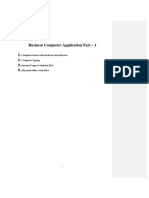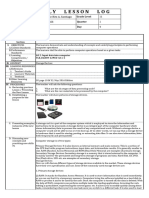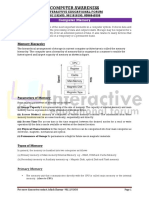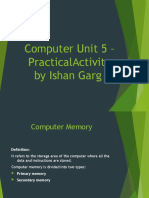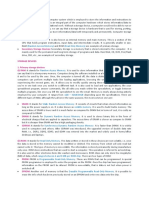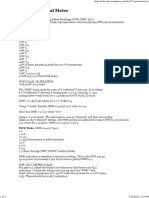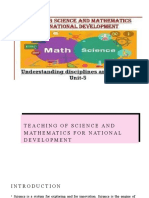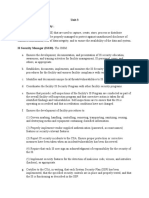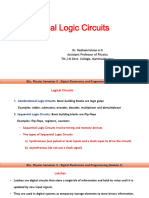Computer Studies Std.
4
2025 - 2026
Ch. 1 Computers - Storage and Memory Devices – Notes
❖ Data and Information
• The set of characters, like letters, digits, or special characters that represent raw facts or
figures are known as data.
• A collection of raw and unorganised facts which do not make sense in itself is known as
data.
• When this data is processed by the processing unit, it becomes useful and is known as
information.
• When any type of data provides a specific context or meaning, it is called information.
❖ Computer Memory
Every computer has a certain amount of memory. The data and instructions that are
entered into the computer using input devices are stored inside the memory of computer. The
memory of a computer is of two types:
1. Primary Memory
2. Secondary Memory
❖ Primary Memory
This is the main memory of the computer. The CPU can directly access this memory.
It is fixed on the motherboard of the computer. The primary memory is further divided into
two types:
1. Random Access Memory (RAM)
RAM is a temporary memory. The information stored in
the memory is lost when you turn off the computer or the power
goes off. That is why, it is known as volatile memory. It is directly
accessed by the CPU and known as the fastest memory of the
computer system. When you start a computer, the operating
system is loaded into RAM. Any software that you run also loaded into RAM.
[It works like a blackboard that can be constantly overwritten with the new data.]
2. Read-Only Memory (ROM)
ROM holds the start-up instructions that prepare a
computer for use. It also consists of programs that check the proper
working of all the computer parts when computer is turned on. The
instructions stored in ROM cannot be changed but can only be read. Unlike RAM, ROM is a
non-volatile memory. It retains the stored information even when the power has been
switched off.
[ROM is like an audio cassette that can be played, but you cannot record anything on it.]
1
�❖ Secondary Memory
This memory is permanent in nature and is not directly accessed by the
CPU. It allows users to store data that may be easily retrieved. Data from secondary storage is
not lost even when the computer is turned off. The secondary memory is essential, because
the internal memory of a computer has a limited storage capacity. They are categorised into
three types.
Magnetic Disk Optical Disc Flash Memory
Hard disk CD Pen Drive
DVD Memory card
External hard disk
Blu-ray Disc Solid State Drive
Magnetic Disk
A hard disk covered with a magnetic coating is called a Magnetic disk. You can
record and erase data on a magnetic disk any number of times.
1. Hard Disk
• The hard disk consists of one or more magnetic disks called platters.
Each disk in the pack has top and bottom surfaces on which data is
recorded using a magnetic head. It is permanently fixed in the computer
system.
• It can hold a large amount of data. Data is recorded on both sides of the
disks.
• The most important function of the hard disk is to store program files and
data files.
• The CPU accesses data stored from the hard disk much faster than it can access data
from the CD.
• Hard disks come in various capacities, 512 GB, 1 TB, 5 TB and so on.
2. External hard disks
• They can be connected to any computer with the help of the
USB port.
2
� Optical Disc
An optical disc is an electronic data storage medium that can be written to and read
using a low-powered laser beam.
1. Compact Disc (CD)
• It is an optical storage device.
• A CD is a thin, shiny, circular disc that can store up to 700 MB of
data and measures 4.7 inches in diameter.
• A CD can hold text, graphics, sound, images and videos. It can be
used for data backups and storing softwares.
• To access data from a CD, you need to place it in the CD drive.
Types of CDs:
1) CD-ROM (Compact Disc Read-Only Memory): A CD-ROM is a pre-recorded CD
containing data or software that has been written at the time of manufacturing. The
data stored on this device cannot be modified or erased.
2) CD-R (Compact Disc Recordable): A CD-R can be used to write data by the user
only once. This data cannot be changed or erased later.
3) CD-RW (Compact Disc Rewritable): A CD-RW can be used to write again and
again. The data stored can be erased and modified as many times as required.
2. Digital Versatile Disc or Digital Video Disc (DVD)
• It is an optical storage device.
• It is used for data storage and recording movies with high-quality
videos and sound. Though, a DVD is similar to a CD in shape
and size, it can store six times more data than a CD.
• The storage capacity of CD varies from 4.7 GB to 17 GB.
3. Blu-ray Disc
• A Blu-ray disc is another optical disc format.
• It can store up to 25 GB of data on its single side and 50 GB on its dual
side.
• Its storage capacity is five times more than that of a DVD.
• The size of a Blu-ray disc is similar to the DVD or CD.
• It is mainly used for storing high quality audio, video and games.
• This disc has derived its name from the blue-violet laser that is used to
read and write data on it.
3
� Flash Memory
Flash memory is a non-volatile storage medium. It keeps information safe
even when the power is turned off. The data from this device can be electrically erased and
reprogrammed.
1. Pen Drive
• A pen drive is the most popular storage device.
• It is a plug and play device and can be connected with the Universal
Serial Bus (USB) port on the computer.
• It is a small, lightweight and removable drive.
• It acts as a portable storage device and is easy to use, as it is small
enough and can be carried in a pocket.
• It is used for copying and moving data from one computer to another.
• It is faster in accessing the data.
• A flash drive can store data upto 1 TB or more.
2. Memory Card
• A memory card is a storage medium for portable devices, like mobiles, digital cameras,
and music players.
• These cards are available in various storage capacities, ranging from 32
GB to 512 GB.
• The data available in a memory card, such as images and music files, can
be accessed via a memory card reader.
• A memory card reader is a small device that is connected to the computer
via a USB port.
• You can insert your memory card in that slot to access the data from the
card.
• Nowadays, computers, laptops, or other gadgets come with inbuilt memory card reader
port.
3. Solid State Drive (SSD)
• An SSD is a type of storage device that holds information, like your pictures, games, and
documents.
• An SSD uses the technique of flash memory to store data.
• It is much faster than a hard disk. SSDs are more durable and
reliable than the hard disks.
• They come in various capacities, typically 128 GB to several
TBs.
• Nowadays, desktop computers and laptops come with SSD
instead of traditional hard disk.
4
�❖ MEASURING THE COMPUTER'S MEMORY
• A computer stores data in digital format, i.e., in the form of 0s and 1s where 0 represents
the OFF state and 1 represents the ON state of signals.
• These two digits-0 and 1 are called Binary digits or Bits.
• The data is stored in a computer's memory in the form of Bits and measured in Bytes.
• A byte is a group of 8 bits for example, 10001011, i.e., 1 byte equals 8 bits.
• A group of 4 bits is known as a nibble (half a byte). For example, 1001 i.e., 1 nibble
equals 4 bits.
* 1 Kilobyte (KB) equals 1024 bytes.
* 1 Megabyte (MB) equals 1024 KB.
* 1 Gigabyte (GB) equals 1024 MB.
* 1 Terabyte (TB) equals 1024 GB.
* 1 Petabyte (PB) equals 1024 ТВ.
* 1 Exabyte (EB) equals 1024 PB.
* 1 Zettabyte (ZB) equals 1024 EB.
* 1 Yottabyte (YB) equals 1024 ZB.
***************************************************************************













